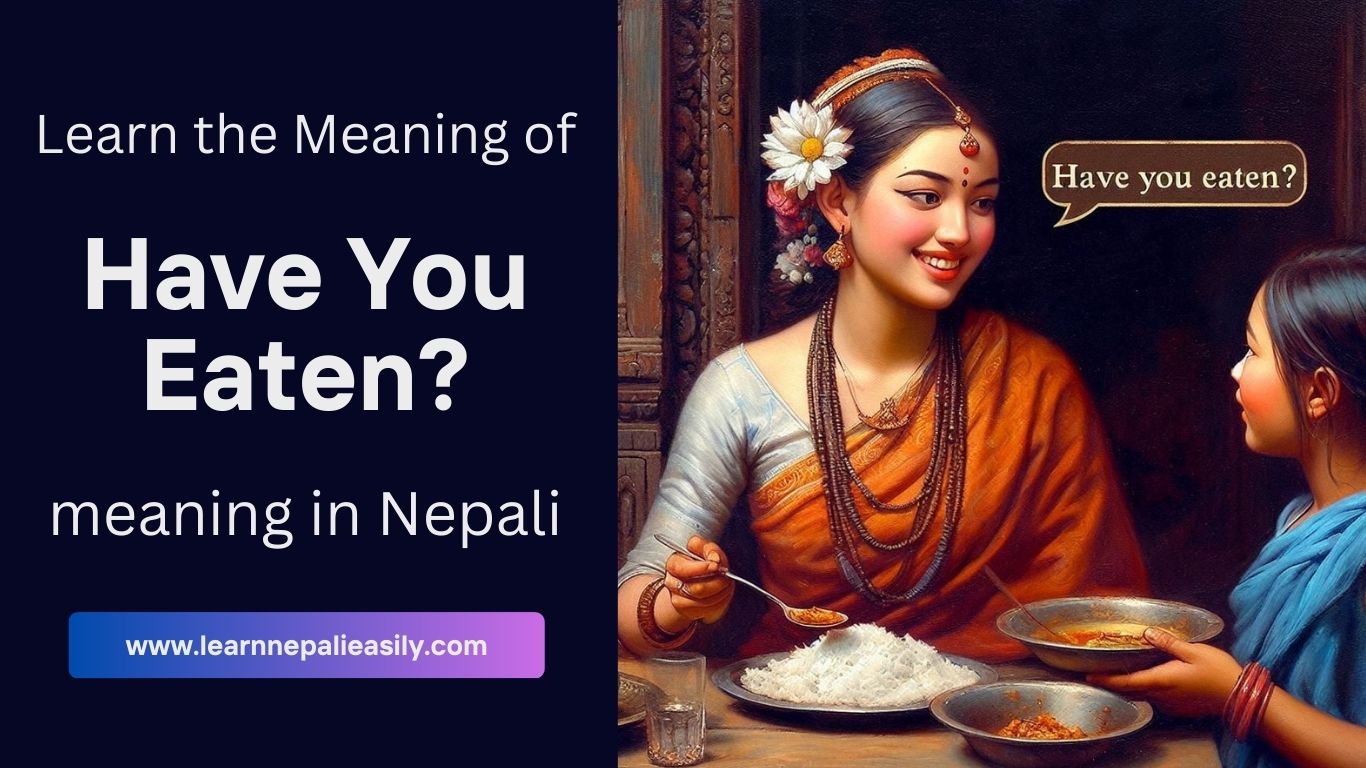In daily conversation, one of the most common questions we ask is, “Have you eaten?” It’s a friendly way to check on someone’s well-being or to start a casual conversation. When learning Nepali, understanding how to ask this question can be helpful in connecting with others. Here, we’ll explain how to say “Have you eaten?” in Nepali, along with examples and practical tips to use it in everyday conversations.
How to Say “Have You Eaten?” in Nepali
The question “Have you eaten?” in Nepali is typically expressed as:
- Nepali: “तिमीले खायौ?” (Timile khayau? / Ti-mi-le kha-yau?)
This is the informal way to ask the question, often used with friends, family, or people younger than you. The word “तिमी” (Timi) means “you,” and “खायौ?” (khayau?) means “have eaten?”
For a more formal version, you can say:
- Nepali: “तपाईंले खानुभयो?” (Tapaile khanubhayo? / Ta-pai-le kha-nu-bha-yo)
Here, “तपाईंले” (Tapaile) is the polite form of “you” in Nepali, and “खानुभयो?” (khanubhayo?) is the formal way to say “have eaten?”
Examples of “Have You Eaten?” in Nepali Conversations
Let’s take a look at some examples of how “Have you eaten?” can be used in different situations:
Example 1:
Nepali: “तिमीले खायौ?” (Timile khayau?) or “तिमीले खाना खायौ?” (Timile khana khayau?)
Translation: “Have you eaten?”
Response:
Nepali: “मैले खाएँ।” (Maile khaye.)
Translation: “Yes, I have eaten.”
Example 2 (Formal):
Nepali: “तपाईंले खानुभयो?” (Tapaile khanubhayo?)
Translation: “Have you eaten?”
Response:
Nepali: “मैले खाएँ।” (Maile khaye.)
Translation: “Yes, I have eaten.”
Example 3:
Nepali: “तिमीले खाजा खायौ?” (Timile khaja khayau?)
Translation: “Have you eaten a lunch?”
Response:
Nepali: “खाँदैछु” (khadaichu) or म अहिले खाँदैछु। (Ma ahilae khadaichu.)
Translation: “I am eating now.”
Example 4 (Informal Conversation):
Nepali: “खाना खायौ कि छैन?” (“Khana khayau ki chhaina?)
Translation: “Have you eaten or not?”
Response:
Nepali: “अहिले खान्छु।” (Ahile khanchhu.) or म अहिले खान्छु। (Ma ahile khanchu.)
Translation: “I will eat now.”
Example 5:
Nepali: “तिमीले बिहान खाना खायौ?” (Timile bihan khana khayau?)
Translation: “Did you eat breakfast?”
Response:
Nepali: “खाएँ” or “मैले खाएँ।” (Khayen or Maile khayen.)
Translation: “Yes, I did.”
Cultural Insights on Asking “Have You Eaten?” in Nepali
In Nepali culture, asking someone if they’ve eaten is not just about food. It’s a way to show care and concern. It’s common for people to greet one another with this question, especially when meeting in the middle of the day or in the evening. It’s also a way to extend hospitality, as food plays a big role in social interactions in Nepal.
Tips for Using “Have You Eaten?” in Nepali Conversations
Be Polite: Use the formal version “तपाईंले खाना खानुभयो?” (Tapainle khana khanubhayou?) when speaking to elders or someone in a professional setting. Khana means food or breakfast/dinner.
Casual Conversations: With friends and family, you can use the informal “तिमीले खाना खायौ?” (Timile khana khayau?).
Variations: You can change the word “खाना” (khana) to “खाजा” (khaja) if you want to ask about a lunch.
Conclusion
Learning how to ask “Have you eaten?” in Nepali can help you build stronger relationships and engage in everyday conversations more comfortably. Whether you’re using the formal or informal version, knowing this phrase will allow you to express care and connect with others on a more personal level.

